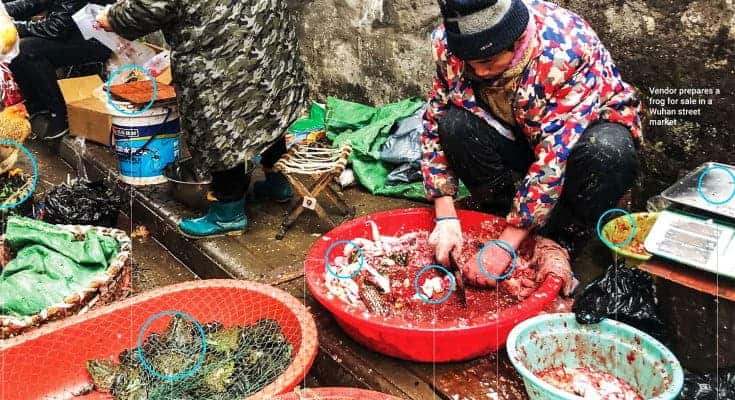The increase in the spread of COVID-19, coronavirus disease 2019 is giving a major threat to the entire world. Being declared as a pandemic it has already killed around 11,888 people across the globe. But, from where did this deadly virus emerge out suddenly? What was its origin? What led to its development as a pandemic?
When the entire world was celebrating New Year’s Eve the health officials at China confirmed the spread of pneumonia resembling mysterious disease. The first case appeared in December 2019 and very soon it got transmitted, grasping the entire county in its deadly claws. In December 2019, 27 of the first 41 people hospitalised (66%) passed through a market located in the heart of Wuhan city in Hubei province. But, What’s so special about Wuhan?
Scientist while searching for its origin got intrigued by the Hunan food market in Wuhan it wasn’t conclusive proof, but the Chinese government immediately ordered to shut down the entire market. An epidemic like this wasn’t something new to the Chinese government a similar outbreak known as SARS, severe acute respiratory syndrome got introduced in the Chinese Mainland in 2002. Evidence pointed out of its birth in another wet market located in southern China, just like Hunan.
Majority of the fatal viruses which affect humans arise from animals. For instance, some of the viruses that cause Influenza come from pigs, Ebola most likely from bats and HIV from Chimpanzees. Continuing with this trend scientists demonstrate some proofs which point Coronavirus of being originated from either Bats or Pangolins. The exceptional ability of viruses to move between species was responsible for letting Corona reach humans. But, even for that, an encounter between all the intermediate and the final specie is a must and that’s exactly where the Hunan market comes in.
“It was not a surprise at all, and I think it was not a surprise to many scientists. The cages are stacked one over another. Animals at the bottom are often soaked with all kinds of liquid. Animal excrement, blood, pus or whatever the liquid they are receiving from the living animals above,” said Peter Li, Associate Professor, the University of Houston-Downtown in an interview with Vox. However, Pengalins or Bats being the final culprit has not been confirmed yet and is still being researched on. A wet market is a market where live animals are slaughtered and are sold for human consumption. Often, the lack of proper hygiene standards at a site where animals are killed and sold simultaneously leads to the origin of such horror causing diseases. But what makes only the Chinese wet markets as the most dangerous in the world?
Wet markets in China, unlike all the others, sell a wide variety of wild animals. Ranging from mice and snakes to peacocks and ostriches they sell everything. And why do they sell it? The answer lies back in the 1970s. China during that time was facing a serious food crisis. The communist regime ruling the country was unable to feed its people, millions died the famine became almost impossible to cope with. Owing to the severity of the condition the government uplifted the ban on private farming, while the rich companies producing pork and meet dominated the trade some of the poor farmers switched to raising wild animals for sustenance.
“At the very beginning, it was mostly peasant household, backyard operations of Turtles, for example. That’s how wildlife farming started to lay the ground. The government needed to encourage people to make living through whatever productive activities they can find them in,” informed Li, further in the interview. Then, in 1988 the Chinese government did one of the biggest errors of all time. It passed the wildlife protection act under which it called all the wild species as the resources of the state and provided protection to the individuals or units engaged in the development or the utilisation of wildlife in accordance with the law and with that, a new industry was born.
With the implementation of this devastating law, not only the number of wild animals but also the variety of species available for consumption increased. A bear farm which started with three started breeding and domesticating thousands of bears. With all this the possibility of selling an infection causing diseased animals increased along. After the 2003 outbreak, the government banned the trade in wildlife but only after a few months it legalized 54 animal species to sell and consume. Though the wildlife trade contributes very tiny in China’s gigantic GDP it’s the industry’s enormous lobbying capability which makes it unable for the government to declare it as illegal. Soon, after the 2019 tragedy, the country has again temporarily shut all similar markets and is facing pressure from the other countries to make the ban permanent.
Feature Image Credits: Bangkok Post
Kriti Gupta





Comments are closed.